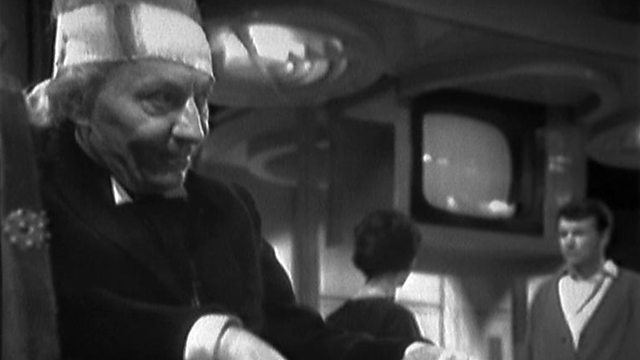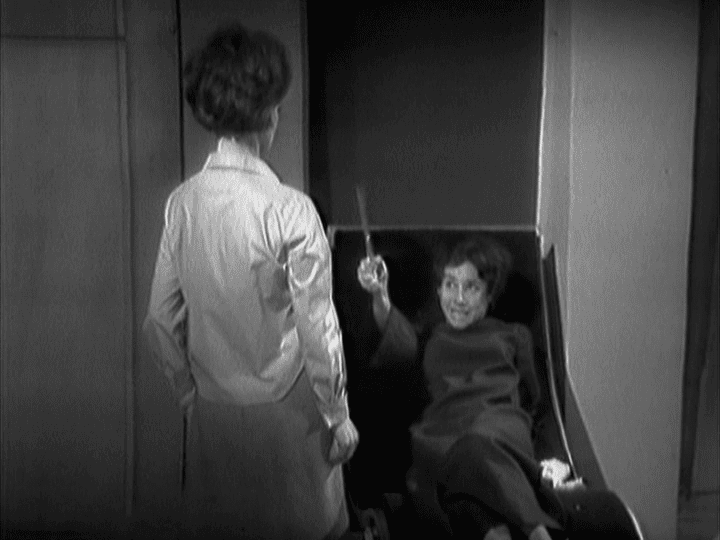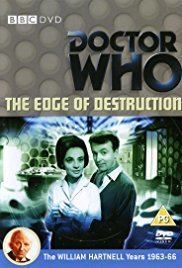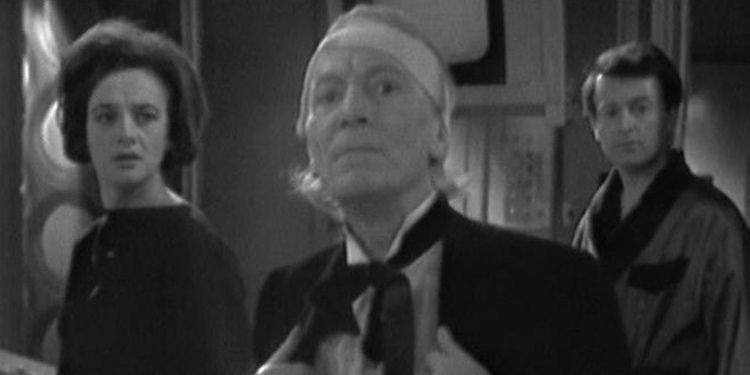Executive producer(s) None | Incidental music composer stock music | |
 | ||
Produced by Verity LambertMervyn Pinfield (associate producer) | ||
Possessed susan attacks barbara the edge of destruction doctor who bbc
The Edge of Destruction (also referred to as Inside the Spaceship) is the third serial in the British science fiction television series Doctor Who, which was first broadcast in two weekly parts on 8 February and 15 February 1964. It was written by David Whitaker and directed by Richard Martin for the first episode and Frank Cox for the second.
Contents
- Possessed susan attacks barbara the edge of destruction doctor who bbc
- Doctor who the edge of destruction creepy fan trailer
- Plot
- Continuity
- Production
- Alternative titles
- Broadcast and reception
- Themes and analysis
- In print
- Home media
- References

In the story, the Doctor (William Hartnell), his granddaughter Susan (Carole Ann Ford), and her teachers Ian Chesterton (William Russell) and Barbara Wright (Jacqueline Hill) are in the Doctor's time and space machine the TARDIS when it appears to be taken over by an outside force. The travellers begin acting strangely and turn against each other.

The serial is distinguished as a rare "bottle episode", in that the entire story is shot on a single set, with just the main cast. It also serves to resolve several character threads that had been presented over the previous eleven weeks.

Doctor who the edge of destruction creepy fan trailer
Plot

The Doctor, while attempting to correct the TARDIS's faulty navigation circuits, causes a small explosion. The Doctor, Barbara, Ian and Susan are all temporarily rendered unconscious. After they awake, Ian and Susan appear to have slight cases of amnesia and everyone begins to act strangely. Unexpected events are happening in the TARDIS, the travellers are becoming suspicious of each other's motives, and the Doctor even accuses Ian and Barbara of sabotage. Fearing that they have been taken over by some alien force—or that they have intentionally sabotaged the TARDIS in order to force the Doctor to return them to 1963—he drugs Barbara and Ian unknowing that Ian is also suspicious and has not taken the drink given to him. The Doctor attempts to explore the problem without interference.

Gradually it becomes clear that the strange events are an attempt by the TARDIS itself to warn the crew that something is wrong. Thanks to Barbara's clue gathering, the Doctor traces the problem to a broken spring in the Fast Return Switch. The malfunction is causing the TARDIS to head back to the beginning of time; the strange events were just the TARDIS's attempts to warn its passengers before the ship is destroyed. Fixing the switch brings all back to normal. Although the day is saved, Barbara is still affected by the Doctor's harsh words earlier. The Doctor is forced to do what he least enjoys—apologise, and admit that he was wrong about Barbara and Ian.
The story closes with the TARDIS materialising on a snowy landscape, where Susan spots a giant footprint in the snow.
Continuity
This serial introduces the ideas that the TARDIS console and time rotor directly harness the energies which drive the ship, and that the TARDIS is "alive" and somewhat self-aware.
This story explicitly states that the Doctor and Susan had visited other worlds before 1963 Earth. Susan mentions that four or five journeys back they had visited the planet Quinnis where the TARDIS had almost been lost.
Production
This story was written by story editor David Whitaker within two days. It was created as a hasty "filler" story so that the series would fit a thirteen-episode run, which was all that had been granted at that stage. Budgetary restrictions meant that only the four regular actors and the TARDIS sets could be used for the filming. Paddy Russell was originally assigned to direct this serial, but she was unavailable for the recording dates so Mervyn Pinfield was suggested as her replacement. Richard Martin was in the end chosen, but he was unavailable for the second episode so Frank Cox had to take over. The episodes were recorded in Lime Grove studio D, 17 and 24 January 1964.
The "fast return" switch label on the TARDIS console appears to be written in felt-tip pen. Exactly why this was done is uncertain; on the DVD, documentary designer Raymond Cusick guesses that it was written during rehearsals as a guide, and producer Verity Lambert surmises that it may have been written so that Hartnell could find the switch. Both agree, however, that the label was probably never intended to be seen. Carole Ann Ford states that she and William Hartnell labelled controls on the TARDIS control panel during rehearsal, and assumed they would be blotted out before production.
Alternative titles
The two episodes of the serial had individual titles. They were, respectively, "The Edge of Destruction" and "The Brink of Disaster." As was the case with other early Doctor Who serials, there are differences of opinion as to the appropriate umbrella title for this serial.
Various titles used over the years include:
Broadcast and reception
The serial was recommended by Charlie Jane Anders of io9 as an example of the classic series for new viewers to watch, describing it as "a quick hit ... and still just as intense as it was 48 years ago". Radio Times reviewer Patrick Mulkern described writer David Whitaker as "a master of dialogue, characterisation and atmosphere", but felt he struggled with plot logic, as evidenced by the fast return switch explanation. Despite this, he stated that the ending had "charm" because the TARDIS travellers had begun to become friends. DVD Talk's John Sinnott felt The Edge of the Destruction was the weakest serial of the programme thus far, writing that it had "some good moments" but "overall it doesn't hang together quite as well" as the preceding two stories. He commented that it felt "rushed" and the resolution was a "cop-out" that failed to explain why the characters were acting so strangely. David J. Howe and Stephen James Walker considered the second episode to be far better than the "uncertain" first episode and thought that overall "Considering its origins as a hasty 'filler' written to bring the initial episode count up to thirteen, Inside the Spaceship works remarkably well."
Themes and analysis
Tat Wood and Lawrence Miles point out the theatrical influence on this story, drawing particular attention to Luigi Pirandello's Six Characters in Search of an Author, and that the point of the story is to lead the audience to think that it's a story about an alien presence infiltrating the TARDIS in order to pull off the twist that the ship is actually conscious. Nevertheless, they suggest that the story's real point - to cheaply fill two episodes at a time when it wasn't clear the show would be renewed - is rather more evident.
In print
A novelisation of this serial, written by Nigel Robinson, was published by Target Books on 20 October 1988 under the title The Edge of Destruction. The cover was made by Alister Pearson. In January 2011, an audiobook of the novelisation was released, read by William Russell.
Home media
The serial was released on VHS in 2000 as "The Edge of Destruction and Dr. Who: The Pilot Episode". The US/Canada release in 2001 also included "The Missing Years" (see Lost in Time) documentary from 1998 (which was released with The Ice Warriors VHS boxset in the United Kingdom). In 2006, it was included on The Beginning DVD box set, along with the previous two serials.
